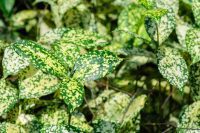What is snake plant? Clinical signs First aid Treatment Prognosis
Snake plant (Dracaena trifasciata syn. Sansevieria trifasciata) is toxic to dogs. The toxic principle is saponins which cause gastrointestinal disturbances in dogs. Saponins are a bitter, soapy substance that protects the plant from herbivory as well as fungal and insect attacks.
What is snake plant?
- Family: Asparagaceae
- Scientific name: Dracaena trifasciata syn. Sansevieria trifasciata
- Common names: St George’s sword, Snake plant, Snake tongue, Mother-in-law’s tongue, Viper’s bowstring hemp, Bowstring hemp, Jinn’s tongue, Devil’s tongue, Golden bird’s nest, Good luck plant
- Toxic parts: All parts of the plant are toxic to dogs
- Toxicity: Mild
- Toxic principle: Saponins

Also known as mother-in-law’s-tongue in reference to the plant’s sharp-edged leaves, snake plant is a hardy succulent native to tropical West Africa that features attractive upright leaves. It is a popular choice of houseplant due to its attractive clean shape, and ease of care.
Popular cultivars:
- Dracaena trifasciata ‘Hahnii’
- Dracaena trifasciata ‘Golden flame’
- Dracaena trifasciata ‘Silver flame’
- Dracaena trifasciata ‘Bantel’s sensation’
- Dracaena trifasciata ‘Laurentii’
- Dracaena trifasciata ‘Twisted Sister’
The University of California classifies snake plants as 2 and 4.
2. Minor Toxicity: Ingestion of these plants may cause minor illnesses such as vomiting or diarrhea. If ingested, call the Poison Control Center or your doctor.
4. Dermatitis: The juice, sap, or thorns of these plants may cause a skin rash or irritation. Wash the affected area of skin with soap and water as soon as possible after contact. The rashes may be very serious and painful. Call the Poison Control Center or your doctor if symptoms appear following contact with the plants.
Clinical signs
Symptoms of snake plant ingestion are typically mild, however, clinical signs can vary depending on the amount of plant consumed as well as the overall health of the dog. The bitter taste of snake plants will deter most dogs from consuming a large quantity of snake plant.
Common symptoms include:
- Loss of appetite
- Drooling
- Vomiting
- Diarrhea
- Abdominal pain
- Dermatitis
First aid
If it is safe to do so, remove any remaining plant matter from the mouth and offer the dog a drink of something tasty. Snake plant ingestion is typically self-limiting, but it is always safer to speak to a veterinarian if your dog has consumed a toxic plant. In most cases, they will recommend self-monitoring at home and if clinical signs develop, to bring the dog in.
Do not attempt to induce vomiting unless instructed to do so by a veterinarian or pet poison helpline.
Treatment
As there is no antidote to snake plant toxicity, treatment is aimed at managing clinical signs. If ingestion was recent, the veterinarian may induce vomiting to help remove plant matter from the gastrointestinal tract. Administration of activated charcoal can bind to any remaining plant matter and prevent further absorption.
Intravenous fluids may be given to prevent or treat dehydration and electrolyte derangements due to vomiting and diarrhea and help to flush any remaining toxins out of the body.
Antiemetics may be administered if the dog is vomiting and gastric protectants can be prescribed to protect the lining of the gastrointestinal tract.
Prognosis
The prognosis for snake plant toxicity in dogs is excellent.
Julia is a writer and landscape consultant from Wollongong with a love of horticulture. She had been an avid gardener for over 30 years, collects rare variegated plants and is a home orchardist. Julia is passionate about learning and sharing her knowledge of plant propagation and plant toxicology. Whether it’s giving advice on landscape projects or sharing tips on growing, Julia enjoys helping people make their gardens flourish.




